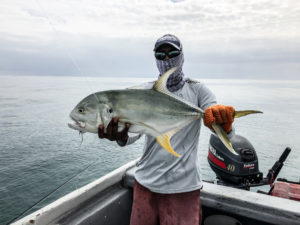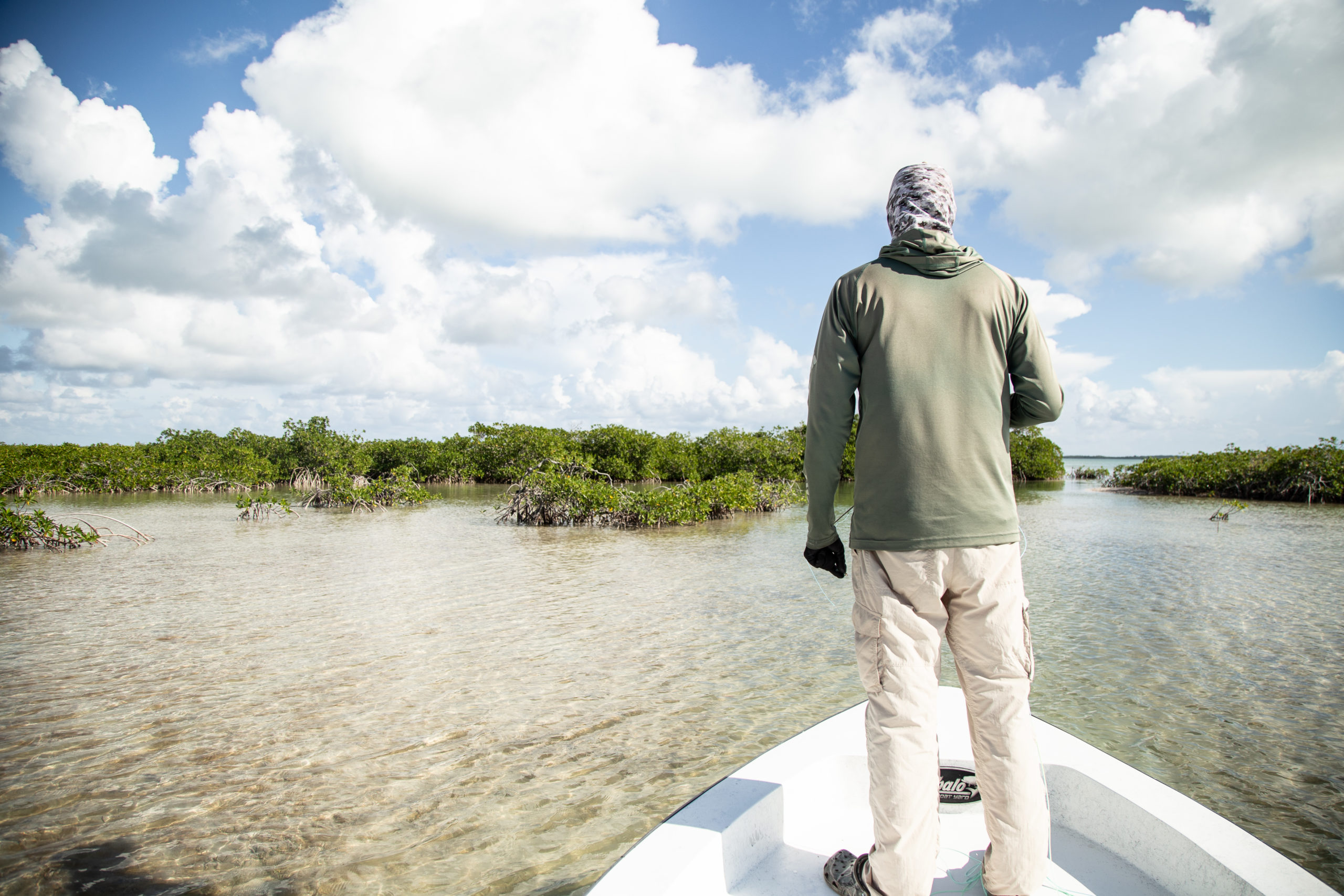
“Eighty feet. Two o’clock. Go!” The cadence of my heart increased until I thought it was about to beat through my chest. With a tarpon visible against the cream-coloured bottom, I was told to make a backhand cast into a stiff crosswind and drop my fly on a target the size of a dinner plate. Right.
But they say even a blind horse finds water once in a while and my white Tarpon Toad whistled through the air and landed precisely where I had intended, with slightly more authority than I would have liked. The tarpon now had a tantalizingly presented fly resting less than three feet from the tip of its beak. Strip, strip, pause. Both my hands were shaking uncontrollably. The fish swam slowly towards the fly but decided this was not to be my lucky day, then it exited the wind-blown flat. Game over.
Saltwater fly fishing is a voraciously addictive sport, one that leaves anglers yearning for more as soon as the plane touches home tarmac. I occasionally find myself obsessively scrolling through photos on my hard drive, immersing myself in the emotions of some of these saltwater fly-fishing memories. I can never forget the moment I cradled my first bonefish, coming to the realization that what I had seen in magazines and on television had just been manifested in my own experience. With both heartbreaking defeats and slim slivers of victory, flats-fishing can forever skew your perspective of what great fishing really is.
Your first saltwater fly fishing venture will most likely be the most defining fishing trip of your lifetime. Here are six tips to maximize the experience and get you started on the right path.
- Do your Homework
In the world of saltwater fly-fishing travel, research or lack of it can make or break the trip. It’s all too easy to jump on the first great deal you find for a week of fishing in paradise, only to show up and learn that not only is your room infested with cockroaches and the toilet doesn’t work, but it’s actually low season and fishing has been dismal. The power of the Internet allows us to go in-depth when researching and comparing destinations and various fly-fishing operations. There is also a multitude of spectacular booking agents in the fly-fishing industry who know their destinations inside and out and who don’t charge a premium for their services.
Saltwater flats-fishing is often regarded as an expensive, unattainable goal for those outside the small percentile of wealthy anglers with ample free time. This is far from reality; it’s often much cheaper to travel to a renowned fly-fishing destination than you might think.
In order to research a destination effectively, ask yourself this question: “What is it that I’m truly after, and what would make this a great trip?” Look at this as being the best saltwater trip you could ever imagine, and work backwards from there. How high are your expectations? What is your main target species? What does travel look like getting to and from, and what is the best time of year to go?
A few key points to note when doing the background work:
- What am I realistically willing to spend?
- Do I need any special visas to enter the country?
- Can I find a reputable lodge, hotel and/or guide service within my budget?
- Is this area safe to travel to as a tourist, and do I need to know a second language to converse in in case of emergency?
- What attracts me to this destination aside from the fishing?
- Will I be purchasing my own rods, reels and lines prior to the trip, and will this affect how much I’m able to spend on the trip?
Take the last one into heavy consideration. Nobody wants to be on their dream fly-fishing vacation but afraid to spend the extra two bucks for a side of guacamole with their tacos. Know what you want to spend, give yourself a little wiggle room for unexpected events, and prioritize what matters most.
Are you the type of angler that is fine sleeping in a bare-bones room as long as it has good foot-access to a nearby flat? Is a DIY lodge going to be a much better experience than an all-inclusive one? There’s nothing wrong with dialing back on optimism if it means saving you from making an impulsive decision.
Lastly, if gear is not supplied and you are ready to invest in yourself, do it right the first time. Third-world countries are not places for equipment failures or shortages. This doesn’t mean you have to splurge. Quality gear at excellent prices has never been more readily available than it is today. Doing a bit of reading, and asking questions of experienced anglers will ensure you find quality products that fit your price range.

- Practice And Prepare
Few things rival the moment of stepping onto the bow of a skiff, pulling a generous length of line off your reel, cradling the fly in your fingertips and awaiting your guide’s call to cast. Guides in this game work exceptionally hard, and they expect the angler to deliver when given the opportunity.
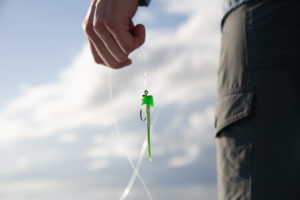
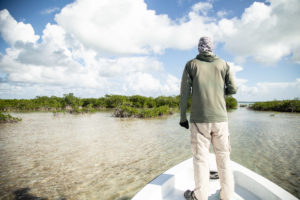
Preparing both physically and mentally before your trip is imperative. There’s a giant difference between casting at a target in a soccer field and casting at a group of tailing permit. Learning to double-haul is much easier at home under the watchful eye of a casting instructor than it is with your guide yelling at you from the poling platform between wind gusts.
If you are doing a DIY trip, the importance of practice and preparation goes a country-mile further. Understanding what knots, flies, lines, rods and equipment you’ll be using in which situations saves a lot of scrambling when it’s game time. Class tippet? Shock tippet? Stripping guards? Should I have brought wading shoes? What on earth is a “Slim Beauty?” These are questions you want to ask your Google search bar while you’re still at home.
Pack extras of everything, and familiarize yourself with the behaviour of your rods, reels and lines. Dedicating time to learn the small idiosyncrasies of your equipment before departure will eliminate surprises on the water.
Lastly, take appropriate clothing. It’s impossible to emphasize this enough, both for your comfort and your safety. When the sun is blazing and the humidity dial is cranked, you can be extremely uncomfortable if you’re not prepared. Sun-protective shirts, pants, hats and face-masks are necessary parts of the equation, along with the the best quality sunscreen you can find.
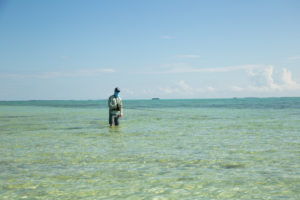
- Learn to Breathe
You probably think you know how to breathe. Yes, but the ability to go a step further in focusing on and controlling your breathing will allow you to exponentially increase your performance under pressure. No matter how much grass-casting, fly tying and book-reading you do prior to the trip, you’re still probably going to freak out when the guide tells you to cast.
Learning to use your breath effectively slows the release of cortisol, the stress hormone, and allows you to stay calm and balanced even when you feel you might pass out. Fly fishing is a relaxing sport until it’s not. There is nothing relaxing about watching two dozen permit swim towards you while you patiently wait for your guide to call the shot.
A couple years ago I stumbled across a technique called “box breathing” to help calm the powerful nerves that would take over when it was my turn to cast. I owe some magical fly-fishing moments (including my first permit) to this simple practice. Box breathing is inhaling through your nose, holding the inhale, exhaling through your mouth, holding the exhale, and repeating. The key, and where this technique gets its name, is to perform this on a 1:1:1:1 ratio. Four seconds for each step seems to be the magic number for me. Familiarize yourself with this technique leading up to your trip and notice its ability to force you into relaxation.
- Listen to your Guide
Countless times I have heard my guide call for me to cast, but I spent too long hesitating and attempting to spot the fish myself. The opportunity was totally blown because I didn’t listen. “Forty feet, one o’clock,” does not mean “Try your best to see what I can see from my incredible vantage point, though you are situated much lower.” It means “Cast. Now!”
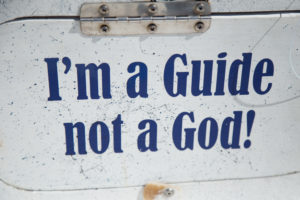
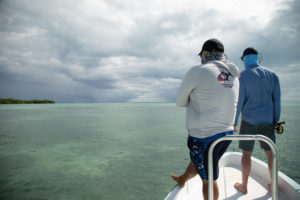
Understand that when you enter the skiff, you’re stepping into your guide’s office and workspace. This is where he makes his living, and remember that you are the student. Approach every day with a “beginner’s mindset” – one in which your ego is left at the dock and you’re fully committed to absorbing as much knowledge, direction and information as possible every day. If you do this you’ll not only become a capable saltwater angler in a much shorter time, you’ll be an enjoyable companion in the boat.
In many destinations the people poling the skiffs are second or third-generation guides who have dedicated their adult years to mastering the local fishery. Their words hold weight; they will not tell you to cast without unwavering certainty that it is the right time to cast. Your success is their success. Understand that when flats guides are being stern with you, it’s because they want to see you succeed. They rarely take a rod in their own hands, so you are the means by which they fish these waters.
Lastly, just listening to your guide is often not enough. Communication back and forth can erase any and all assumptions, and give you the power of clarity that’s so valuable when receiving instruction. If you’re called to make a cast and you truly believe it’s beyond your skill level, say something! Often the guides will do everything in their power to move you from your backhand to your forehand, or move the boat closer to the fish.
Flats fishing is often a team sport. Having a guide that is immersed in the craft and dedicated to making your time a success is a valuable component to any trip. All guides have their own character, methods of communication, demeanour, and tricks they have likely used for decades. You’ll sometimes hear conflicting advice or instruction from different guides. Simply roll with what they tell you and try to pick out the bits and pieces that resonate with you most.
- Master the Strip-Set
A sad, short run-down of my first connection with a fish on the flats: A pair of wonderfully sized bonefish were cruising towards me as I waded a small flat. They dodged in and out of small patches of turtle grass, occasionally disappearing before making themselves visible again. Their teal-blue backs glowed in the water as I prepared to make a cast when they came within my range. My #6 Bunny Gotcha landed a metre in front of them as they nonchalantly cruised the flat in search of crustaceans. I allowed my fly to settle for a second before making a few long, slow, steady strips. The nearest fish obviously noticed my fly and darted toward it without hesitation. I kept up the pace of my stripping cadence as I watched the fish inhale the fly, my running line jolting out of my hand. This was my moment, and despite all the articles I’d read, situations I’d visualized, shows I’d watched and hook-sets I’d practiced, I lifted the rod tip as though I were setting the hook on a small rainbow trout that had just sipped a dry fly. The hook came flying back toward me as the fish spooked off the flat. Note: this is what you’re not supposed to do. What you are supposed to do is set the hook by stripping the fly line firmly with your line-hand while keeping the rod tip low. It’s much easier said than done – especially for a trout angler.
Why does the strip-set work so effectively, and a trout-set not? Strip-setting is advantageous on a number of fronts, the first being that the shock absorption of the rod is removed from the equation, and the direct connection to your fly with the rod tip pointed at the fish gives you much more power to drive the hook into the corner of the fish’s mouth. Secondly, in the event that your fly gets picked up and dropped by a fish, a strip-set keeps the fly in the water where it has another chance to be eaten. A trout-set removes the fly from the water completely.
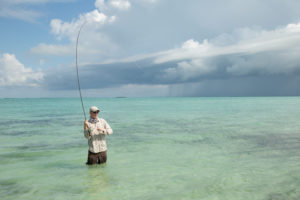
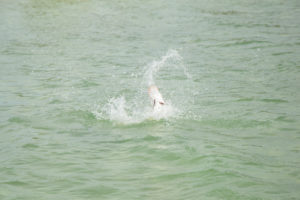
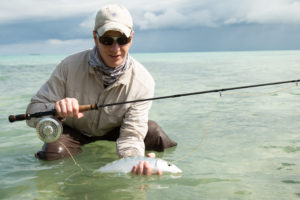
- Manage Your Expectations
Understanding the multitude of possibilities allows you to maintain an open mind and enjoy the adventure regardless of circumstance or outcome. You might be given un-fishable conditions for the first three days of a five day trip, or your luggage might not only be delayed by a week, but could be missing important items when it does arrive. Or maybe you had the best trip you could ask for but came up short of landing a grand slam (bonefish, permit, tarpon). Understand the difference between aiming high and setting yourself up for disappointment. It’s great to have a vision of what you want to accomplish on your first saltwater trip, but it’s necessary to travel with the understanding that you can’t always plan things perfectly in advance. Assessing a worst-case scenario and coming up with a Plan-B can turn a disappointing trip into a great trip. Remind yourself that the results of your fishing efforts are simply a by-product of travelling to and experiencing a new part of the world. Know what sort of experience you’re aiming for, do your research, enjoy not just the fishing but the diversity in culture and cuisine.
Saltwater fly fishing is unforgiving at best, pushing you to limits you didn’t know existed. You will blow a cast, you will lose fish, break leaders, and probably hook yourself. It’s all part of the process. Learn to laugh at your mistakes, because your guide probably already is.
